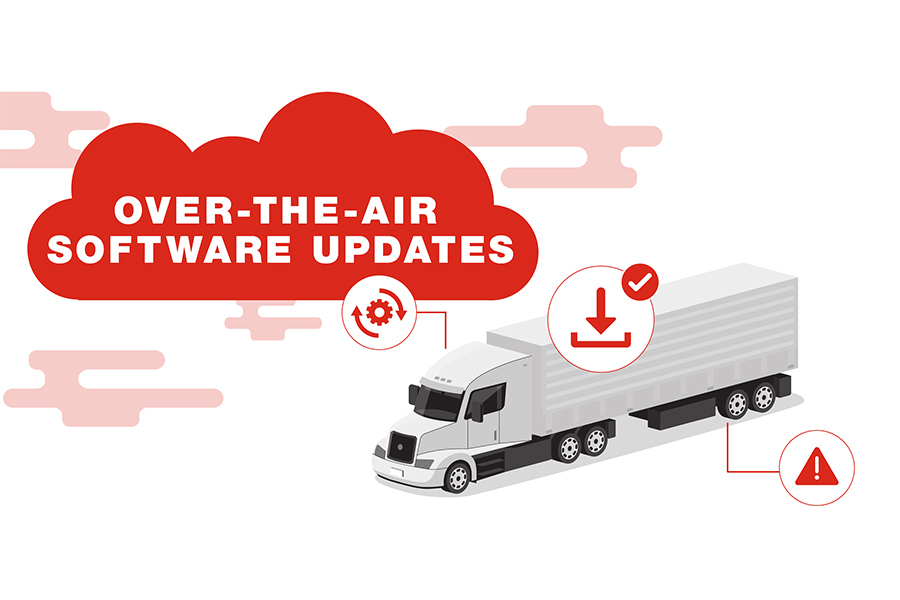Benefits of over-the-air updates
By Cummins Inc., Global Power Technology Leader

As part of our daily lives, we expect all connected devices to automatically update themselves. It gives us peace of mind that our computers and phones are protected against the latest cyber threats and bugs, receiving improved functionality and performance. Cummins Inc. products are no different, with over-the-air (OTA) updates* available for your engine today.
Modern powertrains are complicated systems with many sensors feeding data to electronic control modules (ECMs). The ECM can make real-time changes to various aspects of engine operation, such as fuel injection, ignition timing and emission control, in order to optimize performance.
Through email and the online portal, fleet managers are made aware of software updates that are available from the manufacturer. Vehicles must be stationary to run an update for safety purposes. Updates can be applied in as little as five minutes. This avoids having to schedule trucks for a shop visit to apply these updates, saving time and money.
Updates are made available via Cummins' remote optimization application, Over-the-Air Programming. Cummins' Over-the-Air Programming can send updates directly to the vehicle via Acumen®, Cummins’ advanced computing device, or via an OEM or aftermarket telematics device.

Cost Savings and Enhancements
Remote OTA updates mean that trucking companies can update their vehicles’ software without requiring the physical presence of the vehicle. This feature is especially beneficial for companies with large fleets, where updating each vehicle individually can be time-consuming and costly. OTA updates allow companies to update a single vehicle or to their entire fleet simultaneously, saving time and money.
By offering more frequent updates, manufacturers can deploy new features and performance enhancements. These can be derived from data gathered from other vehicles over months and years. Updating vehicles also helps to maintain their value in the long term.
Compliance
OTA updates can also help with compliance by making sure trucks meet all necessary regulatory requirements, particularly regarding emissions. OTA updates might also mitigate the need for recalls in the case of faulty emissions or performance systems, preventing major disruptions.
With the advent of OTA updates, manufacturers also face clear regulations on how these updates can affect vehicles. This means updates follow an approval process and do not put them outside the original safety, performance and environmental specifications they were sold under.
Have you considered how much of your fleet is running outdated software or how much time is spent manually updating systems? If you are looking for a way to improve the performance, efficiency and safety of your fleet, OTA updates are a great option. Contact us today to find out more.
Explore Cummins’ full suite of digital service tools, from software and mobile applications to digital hardware geared to optimize the performance and reliability of your Cummins-powered equipment. Ask your Cummins representative or Original Equipment Manufacturer (OEM) about how to sign up for access.
*Eligibility for over-the-air update technology varies depending on engine model year and OEM.
Author Profiles

Cummins Inc., Global Power Technology Leader
Cummins Inc., a global power leader, is committed to powering a more prosperous world. Since 1919, we have delivered innovative solutions that move people, goods and economies forward. Our five business segments—Engine, Components, Distribution, Power Systems and Accelera™ by Cummins—offer a broad portfolio, including advanced diesel, alternative fuel, electric and hybrid powertrains; integrated power generation systems; critical components such as aftertreatment, turbochargers, fuel systems, controls, transmissions, axles and brakes; and zero-emissions technologies like battery and electric powertrain systems and electrolyzers. With a global footprint, deep technical expertise and an extensive service network, we deliver dependable, cutting-edge solutions tailored to our customers’ needs, supporting them through the energy transition with our Destination Zero strategy. We create value for customers, investors and employees and strengthen communities through our corporate responsibility global priorities: education, equity and environment. Headquartered in Columbus, Indiana, Cummins employs approximately 70,000 people worldwide and earned $3.9 billion on $34.1 billion in sales in 2024.
Related Tags